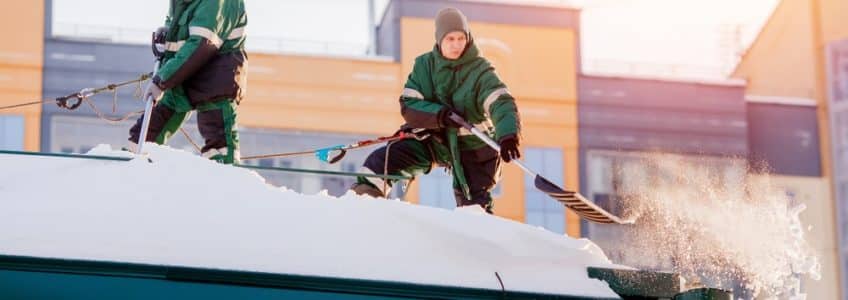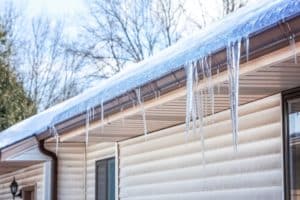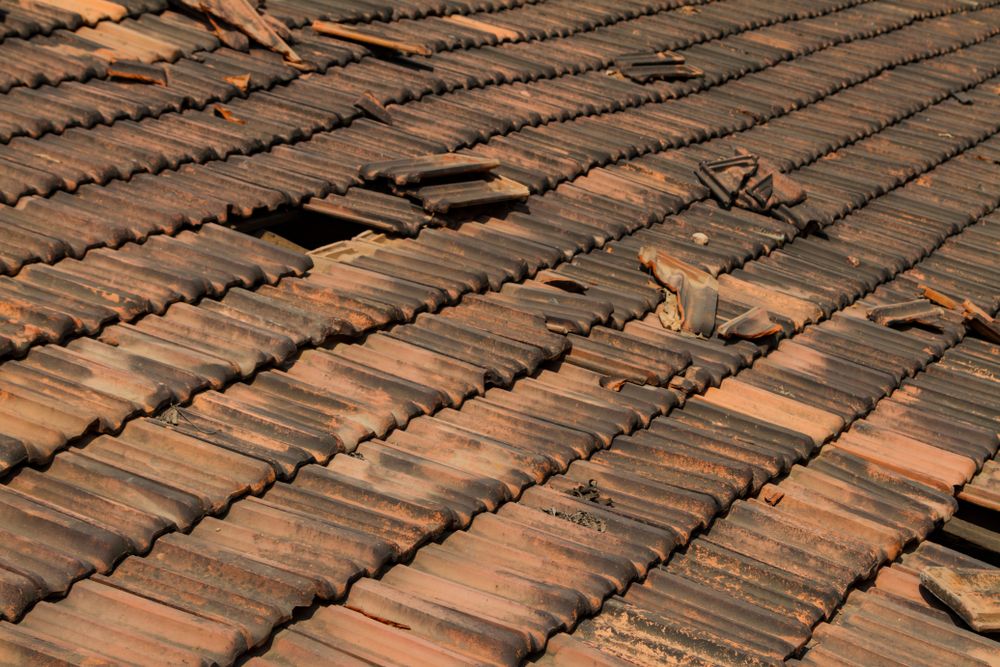
The midwest is known for its cold and long winters. While humans have adapted to live through the winters, our homes and roofs can struggle with the elements. If you own a home in Minnesota, you are likely familiar with the issues that come in winter.
However, a trustworthy roofing contractor can prevent many winter roofing issues and help fix emergencies. Here are the seven most common winter roof problems, what causes them, and how to prevent or fix them.
1. Ice Dams
 Ice dams occur when multiple icicles form, causing a barricade of ice along walls and gutters. This usually happens on residential and commercial buildings without proper insulation or gutters and can cause multiple issues with the home in spring if not dealt with properly.
Ice dams occur when multiple icicles form, causing a barricade of ice along walls and gutters. This usually happens on residential and commercial buildings without proper insulation or gutters and can cause multiple issues with the home in spring if not dealt with properly.
The only safe way to remove ice dams is to hire a professional to come in and steam them away. Steam prevents injuries from multiple icicles and ensures that the entirety of the ice dam is melted away. Then, the roofing experts can inspect the roof for any further damage.
2. Condensation
Condensation occurs when the air is warmer than the liquid (or ice) around it. On roofs, condensation happens if the outside air is cold and the inside air is warm. When you have the heater on, you risk condensation leaks if your roof isn’t insulated.
However, condensation isn’t dangerous unless you have a poorly insulated roof or a drafty house. If the house isn’t sealed properly, the liquid from the condensation could get into the walls and cause mold or liquid damage.
3. Winter Storm Damage
Of course, much of the damage your roof will take throughout winter comes from the elements. Storms, snow, and wind can cause severe damage to a roof and house and should be addressed immediately. If your roof starts leaking after a storm, call a professional and move your family to a different part of the home.
While winter storms can cause damage to a roof, a well-prepared roof should be able to withstand most blizzards. One of the best ways to prevent emergency roof repair is to winterize your roof in the fall. If you invest in this preventative service, you might not need to call us in the middle of winter.
4. Icicles
Like ice dams, single icicles show weak points in the insulation of the house and the gutters. If your house tends to grow icicles, you should look into re-insulating it come spring. However, taking care of the problem is crucial before it becomes an ice dam and causes even more damage to your home.
If you only have a few icicles, take them down safely and keep an eye on the area. Watch the top of the gutter for ice blocks or small dams. If the problem persists throughout the winter or the icicles spread, call a roofing inspector to remove them and ensure the safety of your home and family.
5. Tree Damage and Leaves
Winter storms can be brutal, and fall leftovers can cause more of a problem than you might think. If you forgot to clean your gutters before the first snowfall, you likely have old, dead leaves piling up and causing damage to the edges of your roof.
Full gutters can increase your roof damage, leaking, and flooding risk. In addition to this, heavy winds, snow, or rain can knock over tree branches or debris and cause more damage to your roof. The best way to prevent leaks from nature damage is to ensure that your roof and gutters are clean before winter.
However, you can’t always stop tree branches from falling. If a tree branch has damaged your roof in winter, it can be difficult to know how wide or deep the damage is. Call a roofing contractor to prevent any leaking or further issues, and ask for a complete roof inspection.
6. Flooding and Flashing Leaks
Although it may not seem like winter is a big time for flooding, the weight of the snow on the roof and seams of your house can cause issues. The most common form of flooding in winter is a flashing leak.
Flashing strips are metal strips that are installed on the edges of your roof, wherever it slopes, and around chimneys or other irregularities. They are meant to make the edge areas watertight and weatherproof, but heavy storms during winter can cause them to pull away from the roof and leak.
If you’re experiencing leaking near the edges of your house or underneath your chimney, give us a call. We’re happy to come to take a look at your flashing strips and see if they need to be replaced or if it’s a larger roofing issue!
7. Loose Shingles
Shingles can be knocked loose from strong winter winds, flash leaks, tree branches, and any other winter issue. If your shingles get loose and start to fall off, it’s a sign of an old or damaged roof.
Once you start to see cracked or loose shingles on your roof or shingles on the ground, call your local roofing company to get a full evaluation done as soon as possible. It’s always better to be safe than sorry, and you don’t want a full cave-in in the middle of winter!
Stay Safe and Warm All Winter
 Of course, an ideal winter involves none of these issues. With proper preventative care and a good relationship with local roofers, you can avoid most of these common winter roof issues and stay warm and dry all winter long. However, contact Advantage Construction today regarding your emergency, and we can help.
Of course, an ideal winter involves none of these issues. With proper preventative care and a good relationship with local roofers, you can avoid most of these common winter roof issues and stay warm and dry all winter long. However, contact Advantage Construction today regarding your emergency, and we can help.
